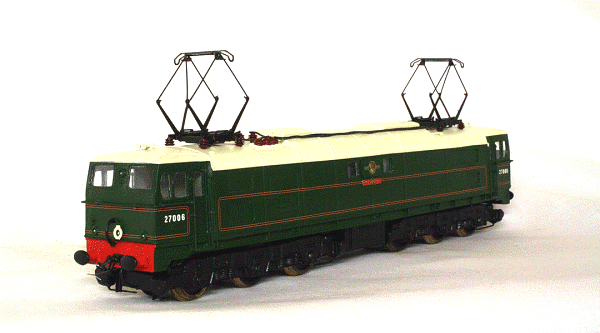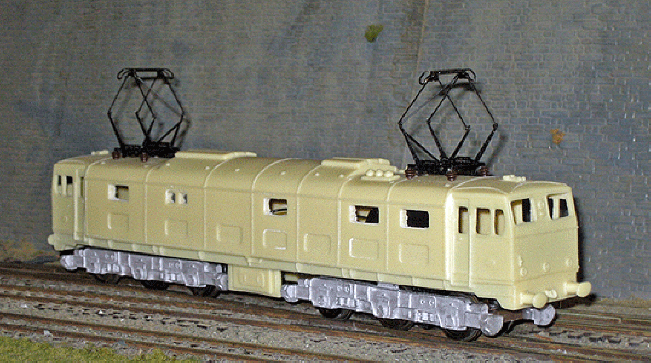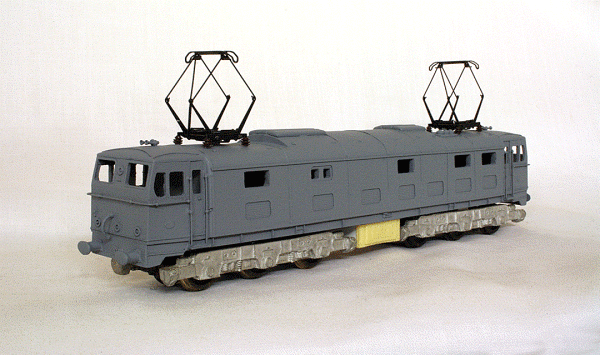Steve Johnson Modelmaker
|
|
BR Class
77 Co-Co 1500V dc Overhead
Class 77 27006 'Pandora' almost finished Built as express passenger locomotives by British Railways Gorton Works in 1953 for the Woodhead electrification, these Co-Co 1,500V DC locomotives were formerly classified as EM2. Although 27 had been planned to be built, a shift to the 25kV ac system during the lines construction meant that the route would become an isolated electric system. As a result, the order was cut back to seven locomotives. The outward appearance was based on the earlier EM1 Class 76 design, with electrical equipment being supplied by Metropolitan-Vickers. Initially painted black and numbered 27000-6, they received the standard green livery about 1960 along with names from Greek mythological characters. The 'E' prefix was added around 1957. A number of locomotives were painted in 'Electric Blue', as carried by the AC electric locomotives. With the run down of the route, the whole class was withdrawn in September 1968 and placed in store at Bury. A year later, the whole class was sold to the Dutch Railways, Nederlandse Spoorwegen, to become NS Class 1500. After a few modifications, the class worked in The Netherlands until 1985, with just one broken up for spares, E27005 Minerva. Three of the class fortunately survive in preservation. E27000 Electra and E27001 Ariadne were repatriated to the United Kingdom at the Midland Railway, Butterley and Manchester Museum of Science and Industry respectively. The third, E27003 Diana, is preserved at the Utrecht Railway Museum in The Netherlands.
The resin body mounted on the shortened Lima chassis The first Class 77 was offered by Tri-ang-Hornby and featured various liveries. DC Kits produced a white metal kit many years ago, but updated it with this resin bodied kit. Heljan have produced a Class 77 exclusively for Olivia's Trains, and like the Class 76, it's not a great model with numerous errors and again very overpriced. As such, I will be sticking to my version. My version is the DC Kits resin bodied kit running on a shortened Lima Class 47 chassis. This is yet another kit that has been lurking on my workbench for years and I thought it was high time I finished it. There is not much to be done to the body and many just clean it up and paint it. I decided that I could improve the appearance by removing the moulded handrails and replacing them with separate wire handrails. The moulded horns were also removed and replaced with turned brass versions. In addition, the moulded coupling hooks were removed with the intention of replacing them with the Hornby screw link version available as a spare part. One thing missing from the model is the prominent brake hose on the cab front. Here I added some white metal brake pipes. Holes in the roof were made for fixing the pantographs, in this case Sommerfeldt 941's. The boiler filler side of the locomotive also has a plate affixed midships between the two small windows that the BR roundal is applied to. This was simply fabricated by a suitably sized rectangle of plasticard. With a bit more tidying up and the addition of some mounting points for the chassis, the body was ready for a coat of grey primer.
The model in primer awaiting final painting The chassis is a Lima Class 47 that has been shortened accordingly. The Class 47 sideframes were removed and the white metal castings fixed in place. Some extra detail is required here in the form of steps and sanding pipes. The front ends of the bogies look a little bare between the sandboxes and suitable detail was added. The Lima chassis can be made to run well with a bit of attention, not least with a good 'running in' session to even out the gears. As my chassis is a later version, it has eight wheel pick up between both bogies. I decided to paint my model in lined green to match my Class 76. I eventually found some photographs of Class 77's in this livery including my chosen locomotive 27006 Pandora. I used Halfords spray paints for painting with Rover Brooklands Green for the main body, Rover Arum White for the ivory coloured roof (although the roof didn't stay white for long!) and Halfords Volkswagon Mars Red for the buffer beams. Transfers were from Fox Transfers with sheet FRH 4050/2 for the straight orange/black/orange lining and sheet FRH 4050/3 for the radiused corners. Numbers were from sheet FRH 4005REV and the BR roundals sheet FRH 4002. With the painting and decals applied, the body was sprayed with Phoenix Precision Satin Varnish PAV72. When dry, the nameplates (Shawplan) were fixed in place using small dabs of Glue'n'glaze. The pantographs were added, fixing them with the supplied screw. More work on the chassis was done. There is a hefty transom fitted between the sandboxes that is quite visible. This was made from plasticard and fixed in place. The guard irons are fixed to the bottom of the transom, again made from plasticard. Sanding pipes were added by drilling holes in the bottom of th sandbox castings and inserting suitably bent brass wire. The bogies and battery boxes were then painted black. The cab interior was painted and a rudimentary control desk added. Glazing was achieved by cutting out pieces of acetate to match the individual window apertures and fixed in place with varnish. This gives the desired 'flush glaze' appearance and hides the thickness of the resin body. The steam heating pipe was added to the buffer beam, as was the Alex Jackson type coupling. The final job was to fit a DCC decoder. In this instance, I hard wired a Lais DCC decoder. Unfortunately, the results with this decoder and an old Lima 'Pancake' motor were not great! Although the decoder worked as such, it proved difficult to control the locomotive throughout the speed range, it moved far too fast. Any attempt at altering the maximum voltage or a bespoke speed table proved ineffective. Having tried various settings, I have concluded that Lais DCC decoders may not be the best option for these older style motors.
|


